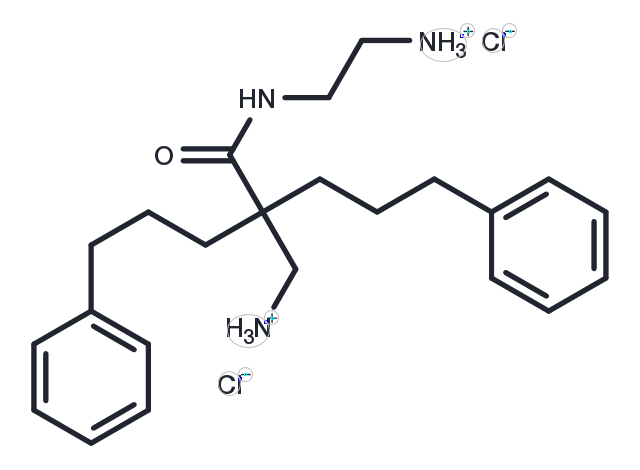Powder: -20°C for 3 years | In solvent: -80°C for 1 year


LTX-401, targets the Golgi apparatus, and is an oncolytic amino acid derivative.

| Pack Size | Availability | Price/USD | Quantity |
|---|---|---|---|
| 100 mg | Inquiry | Inquiry | |
| 500 mg | Inquiry | Inquiry |
| Description | LTX-401, targets the Golgi apparatus, and is an oncolytic amino acid derivative. |
| In vitro | LTX-401 displays the highest cytotoxic activity against the human malignant melanoma cell line MDA-MB-435S (13.5 μM), and is least active against the human hepatocellular carcinoma cell line HEPG2 (35.4 μM). For the remaining cell lines, LTX-401 exhibits similar IC50 values, varying slightly within the range of 19-32 μM. No in vitro hemolytic activity against RBCs is observed using the same concentrations required for the induction of cell death in cancer cell lines. A 50% hemolysis is observed using higher concentrations of LTX-401 (400 μg/mL=1087 μM)[1].LTX-401, an oncolytic amino acid derivative, targets the Golgi apparatus[2].?LTX-401 effectively reduces the viability of several tumor cell lines in vitro, with a similar degree of cytotoxicity against non-malignant cell lines such as HUV-EC-C endothelial cells, HaCat keratinocytes and MRC-5 fibroblasts. |
| In vivo | The majority ?of the animals demonstrate a complete and lasting tumor regression after intratumoral treatment with LTX-401.?Samples are collected from selected animals in the treatment group and control group on days 2 and 7 post-treatment with a single i.t injection.?The immunolabelling of tumor tissue with anti-CD3 antibody reveals that a majority of the infiltrating cells are CD3+ T cells, whereas tumors injected with vehicle only exhibit tumors with a viable tumor tissue, with minimal necrosis and few lymphocytes[1]. |
| Synonyms | LTX-401 dihydrochloride |
| Molecular Weight | 440.45 |
| Formula | C23H35Cl2N3O |
| CAS No. | T13759 |
Powder: -20°C for 3 years | In solvent: -80°C for 1 year
You can also refer to dose conversion for different animals. More
bottom
Please see Inhibitor Handling Instructions for more frequently ask questions. Topics include: how to prepare stock solutions, how to store products, and cautions on cell-based assays & animal experiments, etc.
LTX-401 dihydrochloride (1262851-70-6 free base) T13759 Others LTX-401 LTX-401 dihydrochloride 1262851-70-6 LTX401 Dihydrochloride LTX401 dihydrochloride (1262851706 free base) LTX 401 LTX-401 Dihydrochloride 1262851-70-6 free base LTX 401 dihydrochloride (1262851 70 6 free base) LTX 401 Dihydrochloride LTX401 inhibitor inhibit
